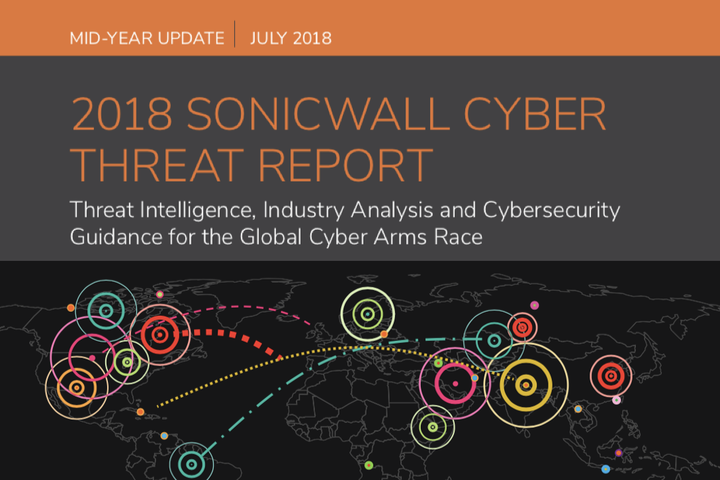Milipitas, US: SonicWall, a global security provider has come out with its latest stats on malware volume and ransomware attacks in 2018 SonicWall Cyber Threat Report.
Malware Volume Still Climbing from 2017’s Record Highs
The malware boom of 2017 has shown no signs of stopping through the first half of 2018. SonicWall Capture Labs threat researchers recorded 5.99 billion malware attacks during the first two quarters of the year. At this same point in 2017, SonicWall logged 2.97 billion malware attacks.
On a month-to-month basis in 2018, malware volume remained consistent in the first quarter before dropping to less than 1 billion per month across April, May and June. These totals were still more than double that of 2017.
Ransomware Back in Big Way
Published in March’s original report, SonicWall Capture Labs threat researchers found that ransomware attacks dropped significantly — from 645 million to 184 million — between 2016 and 2017.
SonicWall now shows ransomware attacks surging in first six months of 2018. There have been 181.5 million ransomware attacks year to date. This marks a 229 percent increase over this same time frame in 2017.
Encrypted Attacks Ascend to Record Highs
The use of encryption continues to grow for legitimate traffic and malicious cyberattacks alike. In 2017, SonicWall reported that 68 percent of sessions were encrypted by SSL/TLS standards. Through six months of 2018, 69.7 percent of sessions are leveraging encryption. Cybercriminals are strategically following this trend to help prevent their malicious payloads from being discovered. Encrypted attacks increased 275 percent when compared to this time in 2017.
“Encrypted attacks are a critical challenge in the industry,” said Conner. “Far too few organizations are aware that cybercriminals are using encryption to circumvent traditional networks security controls, and others aren’t activating new mitigation techniques, such Deep Packet Inspection of SSL and TLS traffic (DPI-SSL). We predict encrypted attacks to increase in scale and sophistication until they become the standard for malware delivery. And we’re not that far off.”
SonicWall Now Blocks Spectre Chip-Based Attacks
The SonicWall Real-Time Deep Memory Inspection (RTDMI TM ) technology now protects customers from Spectre chip-based attacks. SonicWall Capture Labs threat researchers validated RTDMI mitigation against Spectre variants and false positives in production.
“It’s critical for cybersecurity leaders to build innovative solutions that adapt to the changing threat landscape to better protect customers,” said SonicWall CTO John Gmuender. “Cybercriminals increasingly hide weaponized code with more sophisticated obfuscation and advanced custom encryption techniques, then expose, detonate and wipe the weaponized code from memory in real time.”
Since January 2018, RTDMI has identified and blocked more than 12,300 never-before-seen cyberattacks and malware variants. Included in the SonicWall Capture Advanced Threat Protection (ATP) sandbox service, RTDMI
identifies and mitigates even the most insidious cyber threats where weaponry is exposed for less than 100 nanoseconds. RTDMI protects against chip-based attacks like Meltdown and Spectre, as well as attacks leveraging PDFs and Microsoft Office documents.
“Existing industry sandbox solutions do not perform true real-time analysis of malware and, therefore, ‘blink’; and miss detecting sophisticated weaponry, exposing customers to dangerous threats,” said Gmuender. “By never ‘blinking,’ RTDMI provides incredibly powerful technology that advances state-of-the-art threat protection to block sophisticated attack vectors and protect customers in real time.”
The SonicWall Capture Threat Network
Data for the 2018 SonicWall Cyber Threat Report mid-year update was gathered by the SonicWall Capture Threat Network, which sources information from global devices and resources including more than 1 million security sensors in nearly 200 countries and territories; cross‐vector, threat‐related information shared among SonicWall security systems, including firewalls, email security, endpoint security, honeypots, content-filtering systems; SonicWall Capture Advanced Threat Protection multi‐engine sandbox; and SonicWall’s internal malware
analysis automation framework.

